Topology changes of the regenerating Hydra define actin nematic defects as mechanical organizers of morphogenesis
Posted on: 8 May 2024
Preprint posted on 8 April 2024
From Actin Disorganisation Comes Tissue Organisation - Ravichandran et al. show actin defects predict whether Hydra returns with one head or two.
Selected by Rachel MckeownCategories: biophysics, developmental biology
Background
Morphogenesis, describing how tissues are shaped during development, is tightly coupled to regeneration, sharing common processes and principles. Regenerative systems can therefore be an accessible way to investigate development.
One organism famous for its regeneration is the small cnidarian Hydra, its name derived from the mythical head-regenerating beast1. If you haven’t come across one before, it has a very simple body plan along a single axis, essentially a two-cell thick tentacled tube with a head at one end and a foot at the other. The outer layer has a network of contractile actin fibres spanning multiple cells (supracellular) aligned with the body axis, while the inner layer has actin in rings encircling the body. Hydra became a favourite of biologists for its simplicity but also its regenerative powers, but, unlike its namesake, Hydra only recover one head when one is lost. Well, usually…
Previous studies of the actin networks considered them as liquid crystal-like nematic orders – the fibres are parallel, but not arranged in defined planes. Such systems can have ‘defects’ in their topology, focal points of disruption in the ordered actin arrangement. Mature Hydra has several types of these defined by their ‘topological charge’ – how many times the director orientation rotates when going once around the defect centre. The head and foot have +1 ‘aster’ defects with actin converging on/diverging from a central point, while the tentacle bases have -1/2 ‘comet’ defects with actin ‘curving’ around the defect centre (see Figure 1). These are powerful regulators of tissue stress, controlling how tissues move and deform. In particular, the sites of topological defects in regenerating Hydra coincide with the future mouth and foot2.
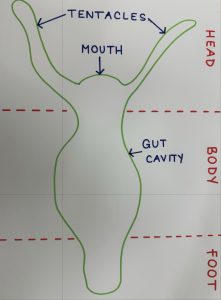
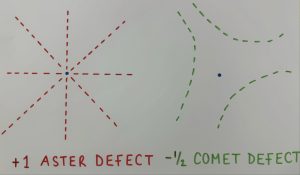
Figure 1: Hydra body plan and actin nematic defects.
In this work, the authors set out to manipulate actin organisation in regenerating Hydra to probe its role further, particularly in defining new heads. Through an elegant interplay of experiment and theory, they reveal that topological defects act as organisers of the regenerating body plan. Taking a broader outlook, they speculate that topology could be a recurring theme in the evolution of common structures in body plans.
Results
To alter actin nematic order while regeneration was underway, Hydra were chopped in half and the tissue piece with the foot preserved (head-regenerating) then sandwiched between agarose and glass. By tuning the stiffness of agarose, they altered the degree of compression. They were confined for four days and released on the fifth, later assayed for regeneration on the twelfth day.
When compressed, the tissue could lie ‘flat’ (lateral), with perpendicular compression, or ‘upright’, with the regenerating head (aboral) or preserved tail (oral) against the glass and compression parallel to the axis. On the softest compression conditions, all tissues were lateral, but with stiffer agarose more were unable to reorientate and hence were trapped in aboral or oral conformations.
In the soft gel conditions, a significant number of embryos regenerated with an extra fully-functional head (so-called biaxial animals). Stiffer gels resulted in more dying, particularly the aboral/oral tissues. This hinted that there might be a ‘sweet spot’ of compression that promoted biaxial regeneration, while not restricting the bodily contractions that are essential for regeneration.
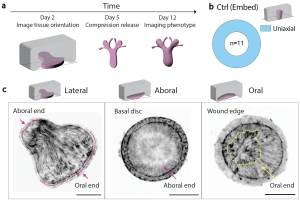
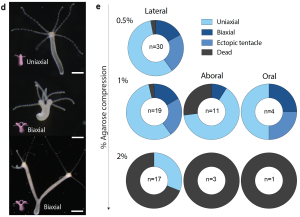
Figure 2: Phenotypes generated by regenerating Hydra under compression/release
They checked out what the actin looked like in the two-headed animals. While the organisation was largely preserved, additional defects were found at the mouth and between the heads. To see what actin was up to as the regeneration process was underway, they switched to live imaging using Hydra with GFP-tagged actin. In cases where the tissue was orientated orally and regenerated biaxially, they could see two +1 asters where the heads emerged and speculated that the orchestration of forces by this defect would sculpt the tissue into a projecting head.
To dive into this further, they turned to computational modelling. Assuming the Hydra tissue to be an elastic force-generating material, they encoded the actin field observed experimentally for biaxial animals. When simulated, a spherical surface split along the centre to give a biaxial form, each head with a +1 aster defect.
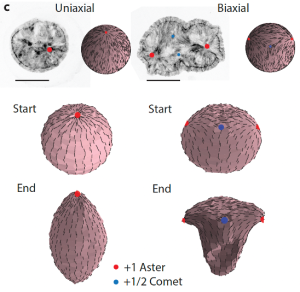
Figure 3: Uniaxial and biaxial regeneration predicted computationally based on actin defects.
Despite being released from compression, some stubborn tissues simply refused to regenerate. Instead, they formed a toroid (doughnut-shape), particularly when aboral/oral, by essentially tearing themselves from the centre and re-healing. Toroids are pretty special topologies as they are the only form in which actin superstructures can be perfectly ordered; with rotational symmetry in their actin orientation, they are devoid of defects. Is this why they don’t regenerate?
To test this, they took spheroids with disordered actin (spheres arising from an excised Hydra body column) and compressed them to form toroids. However, these toroidal tissues did have aster topological defects that emerged as the actin re-organised. These became the later sites of heads and feet, showing that if a toroid does gain a defect, it gains regeneration too. What’s more, when left to fully regenerate, they emerged as toroidal ring-like Hydra, complete with a head and foot. Some even sported some new phenotypes, like two-footed animals!
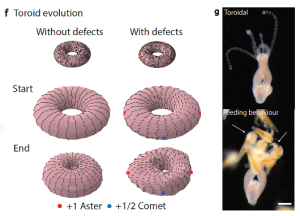
Figure 4: Toroidal models with and without defects and toroidal Hydra
What I liked about this preprint
The role of physical cues in development and regeneration has been greatly underappreciated, with biochemical models dominating the field for decades. This study places mechanics in the spotlight and uses, in my opinion, a really intriguing system to experimentally pin down its role. It’s also refreshing to read a paper that uses a model organism I’m less familiar with – I doubt there are many systems where you can prod and poke so intensively and still successfully generate such outcomes as animals with a hole in the middle! I’ll be on the lookout for more exciting insights from Hydra.
References
- Vogg, M. C., Galliot, B. & Tsiairis, C. D. Model systems for regeneration: Hydra. Development 146, dev177212 (2019).
- Maroudas-Sacks, Y. et al. Topological defects in the nematic order of actin fibres as organization centres of Hydra morphogenesis. Nature Physics 17, 251–259 (2021).
Questions for the authors
- Could a system be developed to compress the Hydra biaxially, or stretch them uniaxially? What would you expect to see?
- Are there any other developmental systems where actin is similarly organised to generate a protrusion?
doi: https://doi.org/10.1242/prelights.37285
Read preprintSign up to customise the site to your preferences and to receive alerts
Register hereAlso in the biophysics category:
ROCK2 inhibition has a dual role in reducing ECM remodelling and cell growth, while impairing migration and invasion
Sharvari Pitke
Effects of transcranial photobiomodulation on peripheral biomarkers associated with oxidative stress and complex IV activity in the prefrontal cortex in rats subjected to chronic mild stress
Rickson Ribeiro, Marcus Oliveira
Condensation of Sidekick at tricellular junctions organizes mechanical forces for cell-cell adhesion remodeling
Fatima Rafiq
Also in the developmental biology category:
Dosage-sensitive RBFOX2 autoregulation promotes cardiomyocyte differentiation by maturing the transcriptome
Theodora Stougiannou
Post-translational Tuning of Human Cortical Progenitor Neuronal Output
Jawdat Sandakly
Aspartate transaminases are required for blood development
Hannah Pletcher
preLists in the biophysics category:
October in preprints – DevBio & Stem cell biology
Each month, preLighters with expertise across developmental and stem cell biology nominate a few recent developmental and stem cell biology (and related) preprints they’re excited about and explain in a single paragraph why. Short, snappy picks from working scientists — a quick way to spot fresh ideas, bold methods and papers worth reading in full. These preprints can all be found in the October preprint list published on the Node.
| List by | Deevitha Balasubramanian et al. |
October in preprints – Cell biology edition
Different preLighters, with expertise across cell biology, have worked together to create this preprint reading list for researchers with an interest in cell biology. This month, most picks fall under (1) Cell organelles and organisation, followed by (2) Mechanosignaling and mechanotransduction, (3) Cell cycle and division and (4) Cell migration
| List by | Matthew Davies et al. |
March in preprints – the CellBio edition
A group of preLighters, with expertise in different areas of cell biology, have worked together to create this preprint reading lists for researchers with an interest in cell biology. This month, categories include: 1) cancer biology 2) cell migration 3) cell organelles and organisation 4) cell signalling and mechanosensing 5) genetics and genomics 6) other
| List by | Girish Kale et al. |
Biologists @ 100 conference preList
This preList aims to capture all preprints being discussed at the Biologists @100 conference in Liverpool, UK, either as part of the poster sessions or the (flash/short/full-length) talks.
| List by | Reinier Prosee, Jonathan Townson |
February in preprints – the CellBio edition
A group of preLighters, with expertise in different areas of cell biology, have worked together to create this preprint reading lists for researchers with an interest in cell biology. This month, categories include: 1) biochemistry and cell metabolism 2) cell organelles and organisation 3) cell signalling, migration and mechanosensing
| List by | Barbora Knotkova et al. |
preLights peer support – preprints of interest
This is a preprint repository to organise the preprints and preLights covered through the 'preLights peer support' initiative.
| List by | preLights peer support |
66th Biophysical Society Annual Meeting, 2022
Preprints presented at the 66th BPS Annual Meeting, Feb 19 - 23, 2022 (The below list is not exhaustive and the preprints are listed in no particular order.)
| List by | Soni Mohapatra |
EMBL Synthetic Morphogenesis: From Gene Circuits to Tissue Architecture (2021)
A list of preprints mentioned at the #EESmorphoG virtual meeting in 2021.
| List by | Alex Eve |
Biophysical Society Meeting 2020
Some preprints presented at the Biophysical Society Meeting 2020 in San Diego, USA.
| List by | Tessa Sinnige |
ASCB EMBO Annual Meeting 2019
A collection of preprints presented at the 2019 ASCB EMBO Meeting in Washington, DC (December 7-11)
| List by | Madhuja Samaddar et al. |
EMBL Seeing is Believing – Imaging the Molecular Processes of Life
Preprints discussed at the 2019 edition of Seeing is Believing, at EMBL Heidelberg from the 9th-12th October 2019
| List by | Dey Lab |
Biomolecular NMR
Preprints related to the application and development of biomolecular NMR spectroscopy
| List by | Reid Alderson |
Biophysical Society Annual Meeting 2019
Few of the preprints that were discussed in the recent BPS annual meeting at Baltimore, USA
| List by | Joseph Jose Thottacherry |
Also in the developmental biology category:
November in preprints – DevBio & Stem cell biology
preLighters with expertise across developmental and stem cell biology have nominated a few developmental and stem cell biology (and related) preprints posted in November they’re excited about and explain in a single paragraph why. Concise preprint highlights, prepared by the preLighter community – a quick way to spot upcoming trends, new methods and fresh ideas.
| List by | Aline Grata et al. |
October in preprints – DevBio & Stem cell biology
Each month, preLighters with expertise across developmental and stem cell biology nominate a few recent developmental and stem cell biology (and related) preprints they’re excited about and explain in a single paragraph why. Short, snappy picks from working scientists — a quick way to spot fresh ideas, bold methods and papers worth reading in full. These preprints can all be found in the October preprint list published on the Node.
| List by | Deevitha Balasubramanian et al. |
October in preprints – Cell biology edition
Different preLighters, with expertise across cell biology, have worked together to create this preprint reading list for researchers with an interest in cell biology. This month, most picks fall under (1) Cell organelles and organisation, followed by (2) Mechanosignaling and mechanotransduction, (3) Cell cycle and division and (4) Cell migration
| List by | Matthew Davies et al. |
June in preprints – the CellBio edition
A group of preLighters, with expertise in different areas of cell biology, have worked together to create this preprint reading lists for researchers with an interest in cell biology. This month, categories include: (1) Cell organelles and organisation (2) Cell signaling and mechanosensation (3) Genetics/gene expression (4) Biochemistry (5) Cytoskeleton
| List by | Barbora Knotkova et al. |
Keystone Symposium – Metabolic and Nutritional Control of Development and Cell Fate
This preList contains preprints discussed during the Metabolic and Nutritional Control of Development and Cell Fate Keystone Symposia. This conference was organized by Lydia Finley and Ralph J. DeBerardinis and held in the Wylie Center and Tupper Manor at Endicott College, Beverly, MA, United States from May 7th to 9th 2025. This meeting marked the first in-person gathering of leading researchers exploring how metabolism influences development, including processes like cell fate, tissue patterning, and organ function, through nutrient availability and metabolic regulation. By integrating modern metabolic tools with genetic and epidemiological insights across model organisms, this event highlighted key mechanisms and identified open questions to advance the emerging field of developmental metabolism.
| List by | Virginia Savy, Martin Estermann |
Biologists @ 100 conference preList
This preList aims to capture all preprints being discussed at the Biologists @100 conference in Liverpool, UK, either as part of the poster sessions or the (flash/short/full-length) talks.
| List by | Reinier Prosee, Jonathan Townson |
BSDB/GenSoc Spring Meeting 2024
A list of preprints highlighted at the British Society for Developmental Biology and Genetics Society joint Spring meeting 2024 at Warwick, UK.
| List by | Joyce Yu, Katherine Brown |
GfE/ DSDB meeting 2024
This preList highlights the preprints discussed at the 2024 joint German and Dutch developmental biology societies meeting that took place in March 2024 in Osnabrück, Germany.
| List by | Joyce Yu |
‘In preprints’ from Development 2022-2023
A list of the preprints featured in Development's 'In preprints' articles between 2022-2023
| List by | Alex Eve, Katherine Brown |
preLights peer support – preprints of interest
This is a preprint repository to organise the preprints and preLights covered through the 'preLights peer support' initiative.
| List by | preLights peer support |
The Society for Developmental Biology 82nd Annual Meeting
This preList is made up of the preprints discussed during the Society for Developmental Biology 82nd Annual Meeting that took place in Chicago in July 2023.
| List by | Joyce Yu, Katherine Brown |
CSHL 87th Symposium: Stem Cells
Preprints mentioned by speakers at the #CSHLsymp23
| List by | Alex Eve |
Journal of Cell Science meeting ‘Imaging Cell Dynamics’
This preList highlights the preprints discussed at the JCS meeting 'Imaging Cell Dynamics'. The meeting was held from 14 - 17 May 2023 in Lisbon, Portugal and was organised by Erika Holzbaur, Jennifer Lippincott-Schwartz, Rob Parton and Michael Way.
| List by | Helen Zenner |
9th International Symposium on the Biology of Vertebrate Sex Determination
This preList contains preprints discussed during the 9th International Symposium on the Biology of Vertebrate Sex Determination. This conference was held in Kona, Hawaii from April 17th to 21st 2023.
| List by | Martin Estermann |
Alumni picks – preLights 5th Birthday
This preList contains preprints that were picked and highlighted by preLights Alumni - an initiative that was set up to mark preLights 5th birthday. More entries will follow throughout February and March 2023.
| List by | Sergio Menchero et al. |
CellBio 2022 – An ASCB/EMBO Meeting
This preLists features preprints that were discussed and presented during the CellBio 2022 meeting in Washington, DC in December 2022.
| List by | Nadja Hümpfer et al. |
2nd Conference of the Visegrád Group Society for Developmental Biology
Preprints from the 2nd Conference of the Visegrád Group Society for Developmental Biology (2-5 September, 2021, Szeged, Hungary)
| List by | Nándor Lipták |
Fibroblasts
The advances in fibroblast biology preList explores the recent discoveries and preprints of the fibroblast world. Get ready to immerse yourself with this list created for fibroblasts aficionados and lovers, and beyond. Here, my goal is to include preprints of fibroblast biology, heterogeneity, fate, extracellular matrix, behavior, topography, single-cell atlases, spatial transcriptomics, and their matrix!
| List by | Osvaldo Contreras |
EMBL Synthetic Morphogenesis: From Gene Circuits to Tissue Architecture (2021)
A list of preprints mentioned at the #EESmorphoG virtual meeting in 2021.
| List by | Alex Eve |
EMBL Conference: From functional genomics to systems biology
Preprints presented at the virtual EMBL conference "from functional genomics and systems biology", 16-19 November 2020
| List by | Jesus Victorino |
Single Cell Biology 2020
A list of preprints mentioned at the Wellcome Genome Campus Single Cell Biology 2020 meeting.
| List by | Alex Eve |
Society for Developmental Biology 79th Annual Meeting
Preprints at SDB 2020
| List by | Irepan Salvador-Martinez, Martin Estermann |
FENS 2020
A collection of preprints presented during the virtual meeting of the Federation of European Neuroscience Societies (FENS) in 2020
| List by | Ana Dorrego-Rivas |
Planar Cell Polarity – PCP
This preList contains preprints about the latest findings on Planar Cell Polarity (PCP) in various model organisms at the molecular, cellular and tissue levels.
| List by | Ana Dorrego-Rivas |
Cell Polarity
Recent research from the field of cell polarity is summarized in this list of preprints. It comprises of studies focusing on various forms of cell polarity ranging from epithelial polarity, planar cell polarity to front-to-rear polarity.
| List by | Yamini Ravichandran |
TAGC 2020
Preprints recently presented at the virtual Allied Genetics Conference, April 22-26, 2020. #TAGC20
| List by | Maiko Kitaoka et al. |
3D Gastruloids
A curated list of preprints related to Gastruloids (in vitro models of early development obtained by 3D aggregation of embryonic cells). Updated until July 2021.
| List by | Paul Gerald L. Sanchez and Stefano Vianello |
ASCB EMBO Annual Meeting 2019
A collection of preprints presented at the 2019 ASCB EMBO Meeting in Washington, DC (December 7-11)
| List by | Madhuja Samaddar et al. |
EDBC Alicante 2019
Preprints presented at the European Developmental Biology Congress (EDBC) in Alicante, October 23-26 2019.
| List by | Sergio Menchero et al. |
EMBL Seeing is Believing – Imaging the Molecular Processes of Life
Preprints discussed at the 2019 edition of Seeing is Believing, at EMBL Heidelberg from the 9th-12th October 2019
| List by | Dey Lab |
SDB 78th Annual Meeting 2019
A curation of the preprints presented at the SDB meeting in Boston, July 26-30 2019. The preList will be updated throughout the duration of the meeting.
| List by | Alex Eve |
Lung Disease and Regeneration
This preprint list compiles highlights from the field of lung biology.
| List by | Rob Hynds |
Young Embryologist Network Conference 2019
Preprints presented at the Young Embryologist Network 2019 conference, 13 May, The Francis Crick Institute, London
| List by | Alex Eve |
Pattern formation during development
The aim of this preList is to integrate results about the mechanisms that govern patterning during development, from genes implicated in the processes to theoritical models of pattern formation in nature.
| List by | Alexa Sadier |
BSCB/BSDB Annual Meeting 2019
Preprints presented at the BSCB/BSDB Annual Meeting 2019
| List by | Dey Lab |
Zebrafish immunology
A compilation of cutting-edge research that uses the zebrafish as a model system to elucidate novel immunological mechanisms in health and disease.
| List by | Shikha Nayar |











 (No Ratings Yet)
(No Ratings Yet)